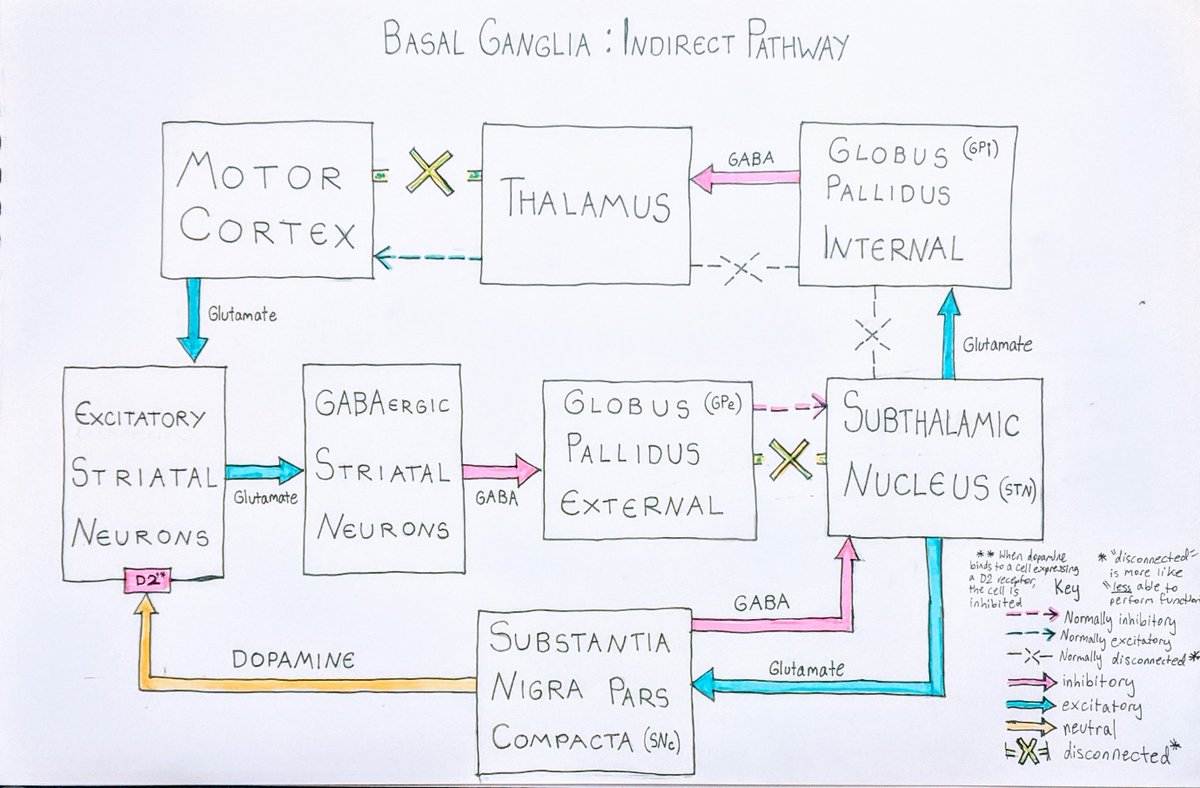Okay. While I will do a Zoom powerpoint in the future to talk about Bayesian reinforcement learning, I do have a thread for you today. I& #39;m going to walk you through the indirect (and maybe direct) pathways of the basal ganglia. here is an illustration I made for you as well.(1/?)
This is almost word for word a description I recently gave someone else, and I& #39;m proud of it! Okay. To start, The basal ganglia is a set of brain structures that are super important for learning rate, decision making, and motor sequence execution. (2/?)
There are two main ‘pathways’ that go through the basal ganglia, the indirect pathway and the direct pathway. Some time ago (and this has changed, but it’s helpful for beginning to understand the pathways) it was thought that the indirect pathway prevents movement, (3/?)
while the direct pathway encourages movement. In the indirect pathway: The first thing to happen is the motor cortex exciting this part of the basal ganglia called the striatum with the excitatory neurotransmitter glutamate. (4/?)
The excited striatal neurons connect to other neurons in the striatum which release an inhibitory neurotransmitter called GABA onto another part of the basal ganglia called the globus pallidus external. (5/?)
Normally, when the globus pallidus external is not being inhibited, its job is to prevent activity in the subthalamic nucleus. The subthalamic nucleus really wants to excite a part of the brain called the globus pallidus internal. (6/?)
So, if inhibitory GABA is being sent to the globus pallidus external (GPe), GPe is no longer able to stop the subthalamic nucleus from getting excited, and the subthalamic nucleus is free to excite the Globus Pallidus internal (GPi). (7/?)
The globus pallidus internal (GPi) is responsible for inhibiting the thalamus, and the thalamus is super important for exciting the motor cortex and telling it to send excitatory signals to motor neurons, which connect to muscle cells. (8/?)
So if the globus pallidus internal is *excited*, it will super-inhibit the thalamus, and prevent those “move!” signals from being sent to the motor cortex, consequently preventing movement. (9/?)
There is a simultaneous & #39;checking& #39; mechanism going on here. The subthalamic nucleus is not being inhibited by GPe anymore, sure, but it is not only sending glutamate to GPi. It is also sending glutamate to another part of the brain: Substantia Nigra pars compacta (SNc). (10/?)
SNc produces the neurotransmitter dopamine. It sends dopamine all the way back to those excitatory striatal neurons that motor cortex was exciting to start this whole thing. These striatal neurons express D2 type dopamine receptors. (11/?)
When dopamine binds to D2 receptors on these excitatory striatal neurons, the excitatory striatal neurons are inhibited, and less able to excite the GABAergic striatal neurons they connect to, which means less GABA goes to GPe. (12/?)
However, this ‘checking’ mechanism is being modulated itself, by an inhibitory pathway that goes from the SNc back to the subthalamic nucleus (STN). (13/?)
By giving different & #39;weights& #39; to different parts of the circuit (think about varying the amounts of neurotransmitter released at each junction), we get a large range of control over the indirect pathway and over inhibition of the thalamus. (14/?)
I& #39;ll explain the direct pathway now (lmk if you would like a visual for this too. Direct pathway is a lot easier. Okay. DIRECT pathway (so NOT the visual attached in the first tweet): Motor cortex excites *inhibitory*, GABA releasing (GABAergic) neurons in the striatum (15/?)
These striatal neurons are now able to send their GABA DIRECTLY to the globus pallidus internal, inhibiting the globus pallidus internal, which stops the inhibition of the thalamus and allows the thalamus to send all of its excitatory “move!” signals to the motor cortex. (16/?)
If the STN is active while the direct pathway is active, then its excitatory glutamatergic connections to SNc will cause SNc to release dopamine to the striatum. But this time, unlike the indirect pathway, the dopamine binds to *D1* receptors on GABAergic striatal neurons. (17/?)
When dopamine binds to D1 receptors, the cell is excited. So these inhibitory striatal cells are being excited with dopamine, and are able to inhibit the GPi a lot more, allowing for more movement. (18/?)
However, this is also checked, by the GABAergic projections that go to the subthalamic nucleus and stop the subthalamic nucleus from exciting SNc. (19/?)
From this we know why signals being sent to the striatum are super important, as are the indirect and direct pathway activation patterns and degrees, and dopamine. But the idea of "indirect pathway will make you slow down and direct pathway will make you speed up" is dated.(20/?)
This is exemplified by one of my favorite papers ever, that came out in 2016 from @YttriLab
Here is the link: https://www.nature.com/articles/nature17639
I& #39;ll">https://www.nature.com/articles/... go over the paper& #39;s most important findings tomorrow :)
(21/?)
Here is the link: https://www.nature.com/articles/nature17639
I& #39;ll">https://www.nature.com/articles/... go over the paper& #39;s most important findings tomorrow :)
(21/?)
Calling this thread done, actually. I will talk about the paper& #39;s most important findings in a separate thread. (22/22)

 Read on Twitter
Read on Twitter


